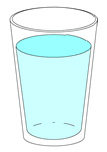Introduction Section
An Interview with Dr. Harkness
Dr. William Harkness provides his own unique introduction in the first part of this series of video interviews about this study.
Case Overview
 In 1956 Piaget and Imhelder argued that a child needs to construct conceptual systems in order to understand spatial relationships, for example, the Euclidean coordinate system. As part of their research they asked children to draw pictures of vertical and horizontal surfaces. In one task (the water-level task) the child is shown a picture of an upright glass half-filled with water. The child is then shown pictures of tilted glasses and asked to draw a line which represents how the surface of the water would look in these glasses. According to their results, by the age of nine or ten most children have mastered this task. However, later studies have shown that many adults, particularly females, have difficulty with this task.
In 1956 Piaget and Imhelder argued that a child needs to construct conceptual systems in order to understand spatial relationships, for example, the Euclidean coordinate system. As part of their research they asked children to draw pictures of vertical and horizontal surfaces. In one task (the water-level task) the child is shown a picture of an upright glass half-filled with water. The child is then shown pictures of tilted glasses and asked to draw a line which represents how the surface of the water would look in these glasses. According to their results, by the age of nine or ten most children have mastered this task. However, later studies have shown that many adults, particularly females, have difficulty with this task.
The robust gender differences observed have had a dramatic impact on the status of Piaget and Imhelder's theory of Euclidean space. If Euclidean space is a construct needed for understanding the relationships between objects in our environment, it is a serious accusation to suggest that large numbers of females lack this construct. Also, if the majority of females do lack this system of reference, it is difficult to explain how they can accomplish tasks such as estimating the trajectories of moving objects while driving an automobile. It seems that the lack of a Euclidean coordinate system would be such a great hindrance that it would be noticeable in everyday life. If the Euclidean system is not used in tasks such as estimating the locations of moving objects, then it is important to discover what skills are facilitated by the Euclidean spatial system.
Some researchers have suggested that many people who fail the water level task may have Euclidean spatial competence, but are affected by specific performance variables and knowledge defects, including
- The ability to draw a horizontal line and the criteria used for passing the task.
- Attempts to draw the water line while the water is moving.
- Understanding and knowledge of relevant physical principles.
- Spatial skills.
The relevant SAS programs and their outputs can be found below:
- water.sas,
- water_level1.sas,
- water_level2.sas,
- water_level3.sas, and
- water_level4.sas.